
Designing the Runabout - By Rick Sternbach.
The design brief for the runabout was to create a small ship that could be housed on Deep Space 9. It was
designed by Rick Sternbach and Jim Martin, who developed a modular design that Star Trek had never used before.
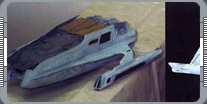 Unlike most Starfleet and alien vessels that sprang from the Star Trek art department, the runabout did not
begin life on myriad sheets of paper, but was the offspring of an existing model that made a brief appearance in
Star Trek VI: The Undiscovered Country. This original model (which was built by John Goodson at ILM) was an
updated version of the original series shuttlecraft Galileo, with recognizable elements such as the forward
windows, aft grille, protruding winglets, and side-opening doors. Incidentally, this model was modified to
become the USS Jenolan NCC-2010 in Star Trek: The Next Generation
episode 'Relics,' and also made a brief appearance in 'Trials and Tribble-ations,' when it delivered the
Temporal Investigations agents Dulmer and Lucsly to Deep Space 9.
Unlike most Starfleet and alien vessels that sprang from the Star Trek art department, the runabout did not
begin life on myriad sheets of paper, but was the offspring of an existing model that made a brief appearance in
Star Trek VI: The Undiscovered Country. This original model (which was built by John Goodson at ILM) was an
updated version of the original series shuttlecraft Galileo, with recognizable elements such as the forward
windows, aft grille, protruding winglets, and side-opening doors. Incidentally, this model was modified to
become the USS Jenolan NCC-2010 in Star Trek: The Next Generation
episode 'Relics,' and also made a brief appearance in 'Trials and Tribble-ations,' when it delivered the
Temporal Investigations agents Dulmer and Lucsly to Deep Space 9.
At first it appeared that this miniature was actually going to be the runabout. However, the producers soon
decided to have us create a unique ship and modify portions of the formerly Cardassian station to accommodate
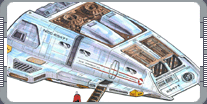 six docking bays. Goodson's handiwork would still provide us with a good starting point; my earliest drawings
reflect the major structural elements of his ship, in particular the forward windows, and entry doors. These
would be the first pieces 'frozen' in the design process, since the cockpit set had to be finished and filmed
before the miniature was completed. Throughout its evolution, the runabout kept the ability to land on a planet,
go atmospheric, and hit mid-warp velocities, but within a few weeks two things happened to change the design
direction and to get us on the road to the final look. First, the producers asked that we make the warp nacelles
and pylons more prominent, since they were signature shapes in Star Trek. A few drawings examined how the
nacelles might be placed, and the favorite scheme seemed to be one with the pylons extending down from the top;
second, illustrator Jim Martin added a new wrinkle to the vehicle by breaking the body into distinct operational
areas, including a command, a cargo/labs section, and a conference or habitation section, all connected by a
structural backbone. Conceptually, a connecting corridor ran below the backbone to access the aft modules.
Soon I created a synthesis of all the ideas we were generating in a few final drawings that the producers could
sign off on.
six docking bays. Goodson's handiwork would still provide us with a good starting point; my earliest drawings
reflect the major structural elements of his ship, in particular the forward windows, and entry doors. These
would be the first pieces 'frozen' in the design process, since the cockpit set had to be finished and filmed
before the miniature was completed. Throughout its evolution, the runabout kept the ability to land on a planet,
go atmospheric, and hit mid-warp velocities, but within a few weeks two things happened to change the design
direction and to get us on the road to the final look. First, the producers asked that we make the warp nacelles
and pylons more prominent, since they were signature shapes in Star Trek. A few drawings examined how the
nacelles might be placed, and the favorite scheme seemed to be one with the pylons extending down from the top;
second, illustrator Jim Martin added a new wrinkle to the vehicle by breaking the body into distinct operational
areas, including a command, a cargo/labs section, and a conference or habitation section, all connected by a
structural backbone. Conceptually, a connecting corridor ran below the backbone to access the aft modules.
Soon I created a synthesis of all the ideas we were generating in a few final drawings that the producers could
sign off on.
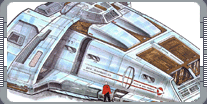 Once the basic hull had been approved, the detailing work addressed all the standard Starfleet parts, plus new
gear required by Martin's cargo pod. The windows, reduced from three to two, were set into a shallow
depression to add a few highlights and shadows; this helped convey a sense of scale and reality to the model.
The 'pancake' warp reactor was placed atop the backbone, with its matter and antimatter tankage and injectors.
The pylons had a few areas trimmed out, and were given phaser strips, plasma conduits, and interesting plating,
again part of the use of texture to convey scale. The command section, now imagined as an escape craft with its
own limited propulsion system, had its nose streamlined. The wignlets and their vertical lift vents were
reduced in size and moved forward. Retaining clamps were added to the backbone to hold the cargo pod;
presumably other mission modules could have been swapped in, but we never got around to it. Sensor strips,
transport emitters, and additional phasers were also spotted around.
Once the basic hull had been approved, the detailing work addressed all the standard Starfleet parts, plus new
gear required by Martin's cargo pod. The windows, reduced from three to two, were set into a shallow
depression to add a few highlights and shadows; this helped convey a sense of scale and reality to the model.
The 'pancake' warp reactor was placed atop the backbone, with its matter and antimatter tankage and injectors.
The pylons had a few areas trimmed out, and were given phaser strips, plasma conduits, and interesting plating,
again part of the use of texture to convey scale. The command section, now imagined as an escape craft with its
own limited propulsion system, had its nose streamlined. The wignlets and their vertical lift vents were
reduced in size and moved forward. Retaining clamps were added to the backbone to hold the cargo pod;
presumably other mission modules could have been swapped in, but we never got around to it. Sensor strips,
transport emitters, and additional phasers were also spotted around.
The only big unknown left was where to locate the impulse engines. The intakes and exhaust nozzles could have
been stuck on or embedded in a thick pylon, but the better location turned out to be under a thinner, more
aesthetically pleasing wing. With the impulse grilles set back, the wing retained its proportions, and the mass
of the impulse system filled in an empty volume that might otherwise have made the runabout appear to be a
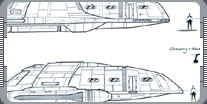 flapping bird. One of the reasons we do drawings in light blue pencil first is to test just these kinds of ideas.
Luckily, over the years I haven't erased as much as I've drawn, but occasionally changes are necessary; a certain
shape might look great initially, but doesn't fit in the overall drawing, or a shape looks good but needs one
last thing to make it perfect. The blueprint phase went smoothly, resulting in all of the orthographic views
needed by Tony Meininger's Brazil Fabrication for the runabout miniature. Tony and his crew built it within
1/8" of the supplied drawings, which is amazingly close. The hull paint scheme, as well as lighting colors for
for the warp, impulse, and formation beacon elements were specified. As the runabout was larger than a typical
tan Starfleet shuttle, it was suggested that the hull be the blue-gray as the
Galaxy-class USS Enterprise
NCC-1701-D. This had the added benefit of contrasting against the warm tones of DS-9 and the Cardassian
warships. A few different shades of hull color and some brown accents, mixed with a bit of space 'weathering,'
did the trick. Rub-down hull markings were designed and printed, including Starfleet emblems and pennants.
flapping bird. One of the reasons we do drawings in light blue pencil first is to test just these kinds of ideas.
Luckily, over the years I haven't erased as much as I've drawn, but occasionally changes are necessary; a certain
shape might look great initially, but doesn't fit in the overall drawing, or a shape looks good but needs one
last thing to make it perfect. The blueprint phase went smoothly, resulting in all of the orthographic views
needed by Tony Meininger's Brazil Fabrication for the runabout miniature. Tony and his crew built it within
1/8" of the supplied drawings, which is amazingly close. The hull paint scheme, as well as lighting colors for
for the warp, impulse, and formation beacon elements were specified. As the runabout was larger than a typical
tan Starfleet shuttle, it was suggested that the hull be the blue-gray as the
Galaxy-class USS Enterprise
NCC-1701-D. This had the added benefit of contrasting against the warm tones of DS-9 and the Cardassian
warships. A few different shades of hull color and some brown accents, mixed with a bit of space 'weathering,'
did the trick. Rub-down hull markings were designed and printed, including Starfleet emblems and pennants.
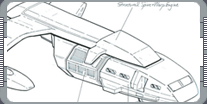 Runabouts were named after major rivers on Earth, like the USS Rio Grande NCC-72452, and the USS Yangtzee
Kiang NCC-72453. Unlike the smaller shuttlecraft, the runabouts received full 'USS' status. The finished
runabout miniature was built with top, bottom, and aft model mounts, and electrical connectors for motion-control
filming. It joined the 'fleet' at the Image G facility for the 'Emissary' VFX shots. Three runabouts lived
aboard DS-9 in specially constructed docking bays, each equipped with a slideaway roof and hydraulic landing pad.
A large miniature of the bay was built to the same scale as the runabout itself, and was photographically matted
into shots of the overall station for launching and landing scenes. In one episode, two runabouts were chasing
each other; to differeniate them, the producers asked for some additional hardware to be added to one of them,
so a large sensor dish was mounted atop the warp reactor. Weapons fire was usually done with the phasers,
although we did add a microtorpedo launcher.
Runabouts were named after major rivers on Earth, like the USS Rio Grande NCC-72452, and the USS Yangtzee
Kiang NCC-72453. Unlike the smaller shuttlecraft, the runabouts received full 'USS' status. The finished
runabout miniature was built with top, bottom, and aft model mounts, and electrical connectors for motion-control
filming. It joined the 'fleet' at the Image G facility for the 'Emissary' VFX shots. Three runabouts lived
aboard DS-9 in specially constructed docking bays, each equipped with a slideaway roof and hydraulic landing pad.
A large miniature of the bay was built to the same scale as the runabout itself, and was photographically matted
into shots of the overall station for launching and landing scenes. In one episode, two runabouts were chasing
each other; to differeniate them, the producers asked for some additional hardware to be added to one of them,
so a large sensor dish was mounted atop the warp reactor. Weapons fire was usually done with the phasers,
although we did add a microtorpedo launcher.
The runabout managed to hold its own until the arrival of the USS Defiant
NX-74205. Then again, maybe it didn't; they did have a tendacy to crash or explode like other Stafleet
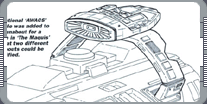 shuttles, with the notable exception of the Rio Grande. In fact, they crashed so often we built a full-size
cockpit exterior for a crashed runabout, complete with escape hatch. Evidently, the emergency separation
system was offline that day! The runabout existed as a miniature for a number of seasons, until the shift to
more computer-generated imagery led to the creation of a textured digital model. This allowed more freedom of
movement, energy effects, and numbers of ships to be assembled for battle scenes. The Starfleet vessel proved
to be a popular item. AMT/Ertl produced a plastic model kit, Playmates marketed a toy runabout to use with
their action figures, and Hallmark sold a light-up Christmas ornament. The design work was an engaging
collaborative experience that produced a little ship with the sense of speed of a business jet and the power of a
twin-engined bomber, and that served Deep Space 9 well.
shuttles, with the notable exception of the Rio Grande. In fact, they crashed so often we built a full-size
cockpit exterior for a crashed runabout, complete with escape hatch. Evidently, the emergency separation
system was offline that day! The runabout existed as a miniature for a number of seasons, until the shift to
more computer-generated imagery led to the creation of a textured digital model. This allowed more freedom of
movement, energy effects, and numbers of ships to be assembled for battle scenes. The Starfleet vessel proved
to be a popular item. AMT/Ertl produced a plastic model kit, Playmates marketed a toy runabout to use with
their action figures, and Hallmark sold a light-up Christmas ornament. The design work was an engaging
collaborative experience that produced a little ship with the sense of speed of a business jet and the power of a
twin-engined bomber, and that served Deep Space 9 well.
|
|
"DESIGNING THE RUNABOUT" - FEBRUARY 2002 ISSUE 34 STAR TREK: THE MAGAZINE COPYRIGHT OF PARAMOUNT PICTURES.
|